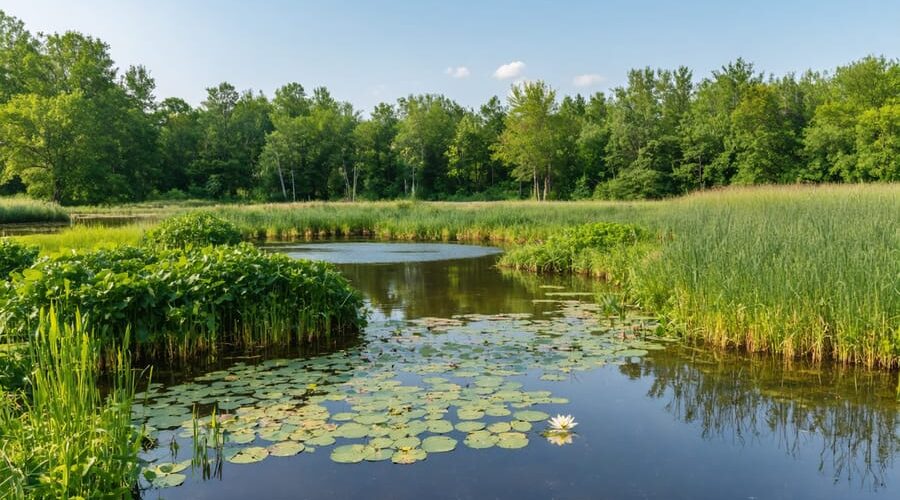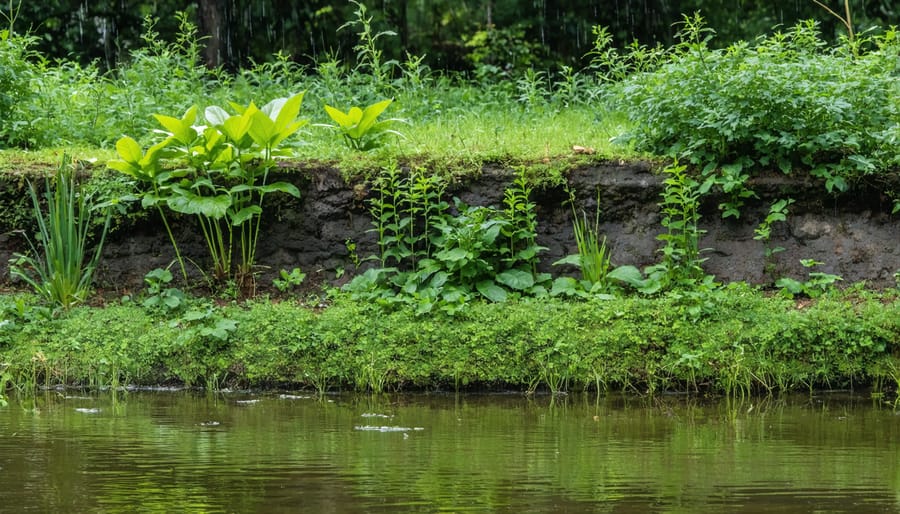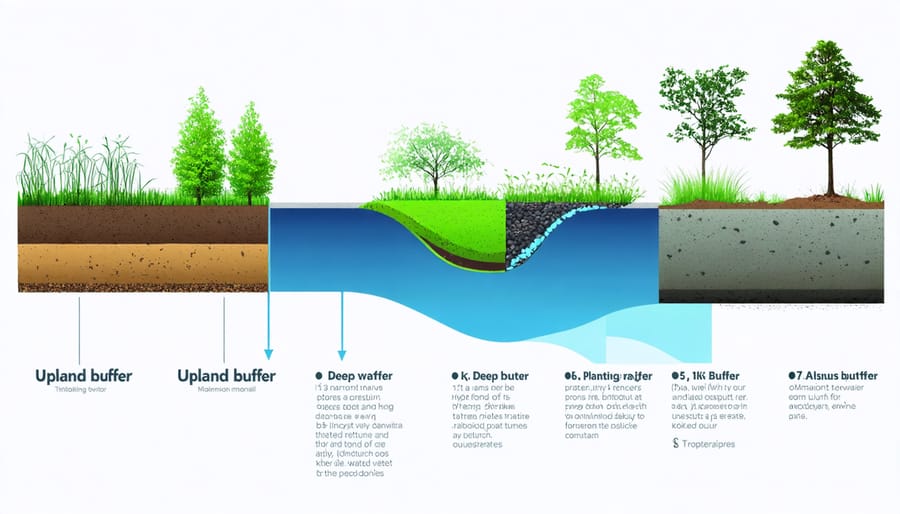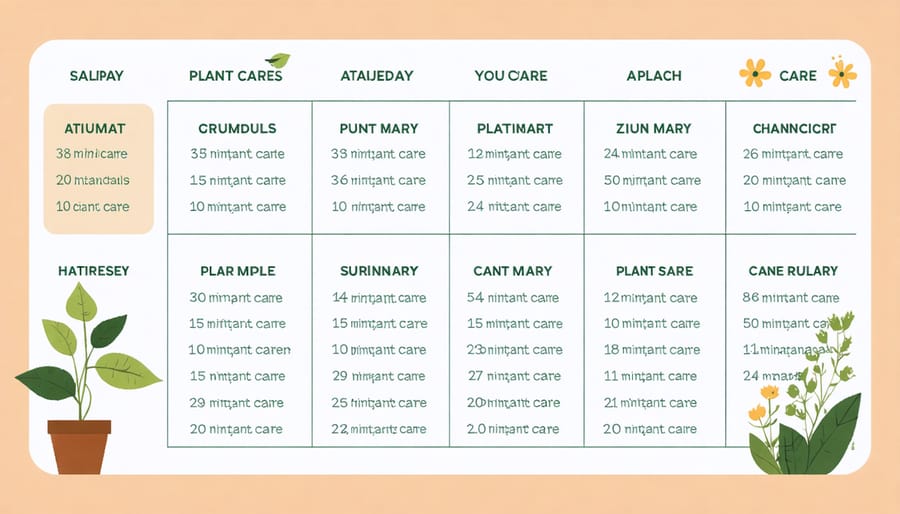
Climate-Ready Retention Pond Plants That Thrive Through Extreme Weather
Transform your retention pond into a thriving ecosystem with the right mix of native aquatic plants. These hardy species not only enhance water quality but also create natural barriers against erosion and flood damage. From deep-water lotus flowers to shoreline sedges, each carefully selected plant plays a vital role in maintaining pond health and stability during extreme weather events.
Strategic plant placement in your retention pond works as a natural filtration system, removing excess nutrients and pollutants while providing essential habitat for local wildlife. Deep-rooted emergent plants like cattails and rushes anchor sediment along the banks, while floating plants such as water lilies help regulate water temperature and reduce algae growth by limiting sunlight penetration.
For maximum climate resilience, layer your pond with three essential plant zones: submerged oxygenators beneath the surface, floating-leaf species at water level, and marginal plants along the shoreline. This multi-tiered approach creates a self-sustaining system that adapts to changing water levels and weather conditions while requiring minimal maintenance.
By incorporating these resilient plant communities, your retention pond becomes more than just a water management feature – it transforms into a beautiful, functional landscape that strengthens local biodiversity and naturally responds to environmental challenges.
Why Plant Selection Matters for Retention Pond Resilience
The Triple Role: Filtration, Stabilization, and Storm Protection
Retention pond plants are nature’s multitasking heroes, serving three crucial roles that make them indispensable for any water feature. As part of effective climate resilience strategies, these plants first act as living filters, absorbing excess nutrients and pollutants while helping maintain crystal-clear water. Their complex root systems trap sediment and prevent erosion, making them excellent stabilizers for pond banks and edges.
But perhaps their most impressive function is storm protection. During heavy rainfall, these plants act as natural shock absorbers, helping to manage water flow and reduce erosion. Their leaves and stems slow down rushing water, while their roots hold soil firmly in place. Think of them as your pond’s personal bodyguards!
For example, cattails and rushes excel at filtering water, while deep-rooted plants like iris and sedges provide outstanding bank stabilization. When planted strategically, these vegetation champions work together to create a resilient ecosystem that can weather whatever Mother Nature throws its way.
Best Native Plants for Weather-Resistant Retention Ponds
Deep-Rooted Marginal Plants
Deep-rooted marginal plants are your best defense against erosion along the edges of your retention pond. These hardy plants form a natural barrier with their extensive root systems, helping to hold soil in place during heavy rains and preventing bank deterioration.
Iris pseudacorus (Yellow Flag Iris) is a top performer, with roots that can extend several feet deep. While it’s beautiful to look at, it’s also tough enough to withstand rushing water and stabilize steep banks. Just be sure to check local regulations, as it can be invasive in some areas.
Rush species like Juncus effusus (Common Rush) are excellent choices for erosion control. Their dense, fibrous root systems create a tight network underground, while their upright growth provides habitat for wildlife above water. These versatile plants can handle fluctuating water levels and look attractive year-round.
For sunny locations, consider Pontederia cordata (Pickerelweed). Its heart-shaped leaves and purple flower spikes add visual interest while its strong roots grip the soil firmly. It’s particularly effective when planted in groups along the waterline.
Don’t overlook sedges like Carex stricta (Tussock Sedge). These grass-like plants form sturdy clumps that excel at soil stabilization. They’re especially useful in areas that experience periodic flooding and can handle both wet and dry conditions.
Plant these species in groups for maximum erosion control, spacing them about 12-18 inches apart. Over time, they’ll grow together to form a living retaining wall that’s both functional and attractive.

Drought-Tolerant Aquatic Plants
When designing a retention pond that needs to manage extreme temperatures and varying water levels, choosing the right drought-tolerant plants is crucial. These hardy species are your best friends during unpredictable weather patterns, adapting beautifully to both wet and dry conditions.
Rush (Juncus species) is a fantastic choice, with its deep roots that help prevent soil erosion while tolerating both flooding and dry spells. Marsh Marigold adds cheerful yellow blooms to your pond edges and bounces back easily when water levels drop. Common Reed (Phragmites australis) is another resilient option, though you’ll want to keep an eye on its spreading tendency.
For shallow areas that occasionally dry out, consider Purple Loosestrife alternatives like Lythrum virgatum cultivars, which provide stunning purple spikes without becoming invasive. Cattails are natural water filters that handle fluctuating levels like champs, though they do need occasional thinning to stay manageable.
Sweet Flag (Acorus calamus) offers attractive grass-like foliage and adaptability to various water depths. For areas that frequently transition between wet and dry, Iris pseudacorus displays stunning yellow blooms while maintaining strong root systems that help stabilize banks.
Remember to plant these species in groups rather than individually – they’ll establish better and create more visual impact while supporting each other through challenging conditions.
Cold-Hardy Water Plants
When winter rolls around, you’ll want plants that can tough it out through the cold while keeping your retention pond healthy and functional. Cattails are champions of cold weather, maintaining their structural integrity even when covered in ice. Their sturdy stalks help prevent erosion all year round, while providing crucial wildlife habitat during harsh months.
Rush species, particularly Hard Rush and Common Rush, are excellent choices that stay green well into winter. These hardy plants continue filtering water and supporting pond health even when temperatures drop below freezing. Their dense root systems remain active, helping to maintain water quality when other plants go dormant.
Marsh Marigold is another fantastic cold-weather performer, often being one of the first plants to bloom in early spring. Its bright yellow flowers bring welcome color to your pond, while its robust nature helps it survive through winter’s challenges.
Don’t overlook Sweetflag, which keeps its aromatic leaves throughout most of the winter in many climates. This versatile plant not only looks good during the cold months but also helps maintain oxygen levels in your pond.
For deeper areas, Water Lily varieties like the Hardy Water Lily can survive winter by retreating to the pond bottom, ready to resurge in spring. Just make sure your pond doesn’t freeze solid – a depth of at least 18 inches will protect these resilient plants during winter dormancy.

Strategic Planting Zones for Maximum Resilience
Buffer Zone Design
A well-designed buffer zone around your retention pond acts as a natural shield, protecting the water from harmful runoff and preventing soil erosion. Start by creating three distinct planting zones: the shoreline, the slope, and the upland area. Each zone plays a crucial role in filtering water and stabilizing the soil.
In the shoreline zone, plant deep-rooted grasses and rushes that can withstand fluctuating water levels. These plants should be placed about 6-12 inches apart to form a dense network of roots that holds soil in place. Popular choices include sedges, rushes, and iris species.
The slope area requires plants that excel at soil stabilization. Consider using a mix of native grasses and flowering perennials that develop extensive root systems. Plant them in a staggered pattern to maximize coverage and ensure there are no bare spots where erosion can occur.
For the upland buffer zone, incorporate larger plants like shrubs and small trees. These larger species help slow down water flow during heavy rains and provide additional filtration. Space them about 3-4 feet apart, and fill the gaps between them with native groundcovers.
Remember to maintain a minimum buffer width of 15-25 feet from the water’s edge for optimal protection. In areas with steeper slopes or heavy runoff, consider expanding this zone to 35 feet or more. Regular maintenance of your buffer zones, including selective pruning and weed control, will ensure their long-term effectiveness in protecting your retention pond.
Deep Water to Shoreline Transitions
Creating a seamless transition from deep water to shoreline is essential for a healthy and visually appealing retention pond. Understanding the crucial pond zones helps you plan your plant placement effectively.
Start by positioning tall emergent plants like cattails and bulrushes at the deepest margins, where they can anchor firmly in the pond bottom while their stems reach above the water surface. As you move toward shallower water, introduce mid-height plants such as pickerelweed and arrowhead, which thrive in depths between 6-12 inches.
In the transition zone, where water meets land, plant moisture-loving species like marsh marigolds and iris. These plants help prevent erosion while creating a natural-looking boundary. For the most shallow areas and shoreline, incorporate creeping plants like creeping jenny or marsh pennywort to form a living carpet that connects water to land.
Layer your plantings by height, with tallest specimens at the back (deeper water) and progressively shorter plants toward the front (shoreline). This creates not only visual interest but also provides essential wildlife habitat and helps filter runoff before it enters deeper water. Remember to space plants according to their mature size, allowing room for spread while maintaining adequate coverage for erosion control.
Maintenance Tips for Long-Term Plant Success
Seasonal Care Calendar
A well-maintained retention pond requires different care throughout the year. Here’s your monthly guide to keeping your pond plants healthy and thriving:
January-February: Most plants are dormant. Remove dead foliage and check for ice damage. If your pond freezes, maintain a small opening for gas exchange.
March: Begin spring cleanup as temperatures warm. Remove debris and trim back any remaining dead plant material. Test water quality and prepare for new growth.
April-May: Active growing season begins. Divide and replant overgrown marginal plants. Add fertilizer tablets to potted aquatic plants. Watch for early-season algae blooms.
June-July: Peak growing season. Monitor water levels and top off as needed. Trim back aggressive plants to prevent overcrowding. Remove spent blooms to encourage continuous flowering.
August: Continue regular maintenance. Check for signs of pest problems. Harvest excess plant material to prevent decomposition in the water.
September-October: Prepare for fall. Stop fertilizing as growth slows. Remove fallen leaves before they sink and decompose. Begin moving tropical species indoors if applicable.
November-December: Final cleanup before winter. Cut back dead foliage to 2-3 inches above water level. Remove annual plants and store tender species. Install protective netting to catch falling leaves.
Remember to adjust this schedule based on your local climate and specific plant varieties.

Troubleshooting Common Climate-Related Issues
Climate changes can present unique challenges for retention pond plants, but with the right strategies, you can help your aquatic garden thrive in any weather. Understanding these common issues and their solutions is key to maintaining a healthy weather-proof pond design.
During drought periods, falling water levels can stress marginal plants. Consider installing a simple water level monitor and supplement with collected rainwater when needed. For submerged plants, temporarily relocating them to deeper areas can help them survive until water levels recover.
Heavy rains bring their own set of challenges. Excess nutrients washing into the pond can trigger algae blooms. Combat this by maintaining a buffer zone of robust plants around the pond’s edge to filter runoff. Plants like cattails and rushes are particularly effective at this job.
Extreme temperatures can affect plant growth and survival. During heat waves, floating plants like water lilies provide crucial shade that helps keep water temperatures stable. In colder regions, protect tender plants by moving them to deeper water before winter sets in.
Wind damage can be minimized by grouping plants together for mutual protection and ensuring marginal plants are firmly anchored. For areas prone to strong storms, choose sturdy native species that have naturally adapted to local weather patterns.
Remember to adjust your maintenance routine seasonally. Regular monitoring helps catch problems early, making them easier to address before they become serious issues.
Creating a thriving retention pond ecosystem with the right plants is both rewarding and essential for water management. By incorporating a mix of submerged, floating, marginal, and deep-water plants, you’ll establish a balanced environment that naturally filters water, supports wildlife, and enhances your property’s beauty. Remember to choose native species whenever possible, as they’re already adapted to your local climate and require less maintenance.
Start small and gradually expand your pond plant collection as you gain confidence. Monitor your plants’ growth and maintain proper water levels to ensure their success. Don’t forget to consider seasonal changes and prepare your pond accordingly, especially in regions with harsh winters.
Whether you’re a beginner or experienced water gardener, implementing these plant suggestions will help create a sustainable retention pond that serves its practical purpose while providing an attractive natural feature. With proper planning and care, your retention pond can become a vibrant ecosystem that benefits both the environment and your landscape for years to come.
